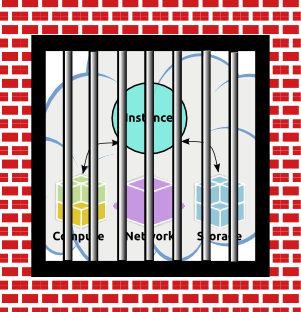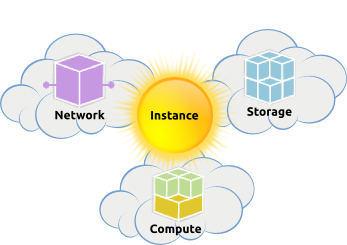OpenStack has a huge opportunity to truly disrupt the cloud space but I’m afraid no one is noticing this.
Cloud is more confining than you think
“Cloud” is still though of by many as a disruptive and freeing model. In fact it’s old news and has become some what ossified. There’s innovation on top but not really in what cloud fundamentally are.
All clouds are run by a single provider (which may be yourself in the case of private clouds), but that provider fully defines the cloud environment, what services are available and what hardware those services run on. In the simplest IaaS case you get something like this.

Now we can add more services like object storage, orchestration, image management, and compose lower level services into Fubar-as-a-Service. But everything must live within that cloud boundary.
This boundary issue is common to all clouds I’m aware of.
In OpenStack land we do a lot of work on interoperability and federation between clouds. This allows you to (more) easily migrate workloads from one OpenStack cloud to another. This is all well and good but the explosion in containers really ate our lunch there. There’s still lots of value to federation and defcore, but neither will change the world if you want portable workloads containerize.
Still, moving workloads is one thing but each is still islanded in what ever cloud they are launched on and can only draw resources from that pool. The fluffy cloud is really more of a prison cell, even if it maybe a minimum security one.

No one much notices because that’s the way it has always been. You pick your cloud or clouds and live in them.
Multi-Provider Cloud
Multi-provider cloud could change everything and it’s almost possible with existing OpenStack using federation. We just need to break the internal assumptions that there can be only one of each service.
There was a cross project working session this afternoon at the Tokyo OpenStack Summit to address this and a working demo on a Nova instance in one cloud attaching a Cinder volume in another cloud.
This is revolutionary.
This reshapes the cloud marketplace. Rather than competing with full cloud stacks vendors could specialize in what they actually do well. Users could select the best components for their needs rather than the best compromise. Hybrid clouds could burst out and get some compute from a public provider while still utilizing their private image and block storage services.
We can see the sun through the clouds!

No one showed up.
OK that’s not true. A number of operators showed up that I recognized,. And lots of Keystone people showed up, but they were mostly already on board. What was missing was, well everyone else and if this is to happen it will likely need everyone else.
I was a bit disappointed by that.
Massachussetts Open Cloud
This work is being done largely by Mass Open Cloud you can find some older presentations and papers there.
Also like all OpenStack shops they’re hiring (dev and ops)…
I recently hitched my wagon to them (my waggon bein gMIT/CSAIL’s production cloud) since we were building clouds in the same data-center we decided to combine efforts. I do production ops things so while I’m working with them that part of the project isn’t my baby. Though my interest in seeing it happen is a large part of why I decided to partner with them.